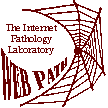- What is the diagnosis?
This is Hashimoto thyroiditis. At low power (image 5.1) can be seen prominent inflammatory infiltrates in the follicles. At medium power (image 5.2) can be seen a lymphoid follicle. The lymphocytes and the pink Hurthle cells are seen at higher magnification (images 5.3 and 5.4).
- What is the etiology?
This is an autoimmune disease associated with HLA DR5.
There is a deficiency in suppressor T cells, TSH receptor antibodies (of
the TGI type), and anti-thyroglobulin and anti-microsomal
antibodies.
- Is the lymphoid population polyclonal or monoclonal?
It is polyclonal (reactive).
- What laboratory studies would have been useful preoperatively?
Both anti-thyroglobulin and anti-microsomal antibody tests
would have been helpful. Fine needle aspiration (FNA) cytology would have
helped.
- What are the indications for surgery?
Lymphadenopathy and rapid growth that suggest the possibility of neoplasia may be indications for surgery.
- What is the typical clinical course for these patients?
Early in the course, the T4 is normal or increased, but as the
disease progresses, there is loss of follicles with fibrosis and atrophy, and eventually hypothyroidism occurs. Hashimoto's thyroiditis is a common cause for hypothyroidism in adults.
- What long-term therapy is needed?
Thyroid hormone replacement therapy is needed as thyroid function decreases over time. Thyroid disease affects up to 1 in 200 persons in the U.S., with a higher prevalence in women and the elderly. Hormone replacement should be started a low dosage and increased gradually, especially in the elderly and in patients with cardiac problems. Laboratory values should be monitored six to eight weeks after any dosage change. Once a stable dosage is achieved, annual monitoring of the thyroid-stimulating hormone (TSH) level is probably unnecessary, except in older patients.
Otherwise healthy adults require 1.7 micrograms per kg per day of levothyroxine. Older persons may require only 1 microgram per kg per day. This means that most adults require from 0.10 to 0.15 mg peer day to remain euthyroid. The usual dosing regimen is once per day.

- If she is poor and uninsured, how will she pay for it?
Despite spending more per capita than any other nation, The U.S. has a large portion of its population at risk for absent or substandard health care. Of the 26 richest industrialized nations, only 1 (the U.S.) lacks universal health care. Medicaid programs try to cover persons who otherwise would not receive health care, but access is still a struggle. Medicaid programs are funded by individual states, most of which have an increasing gap betweeen revenue and funding needs.
Physicians have traditionally opposed universal health care, but in countries with universal health care, physicians remain well-paid, and people live longer, healthier lives. Health care organizations, including hospitals, can function more effectively within a stable system of funding.



